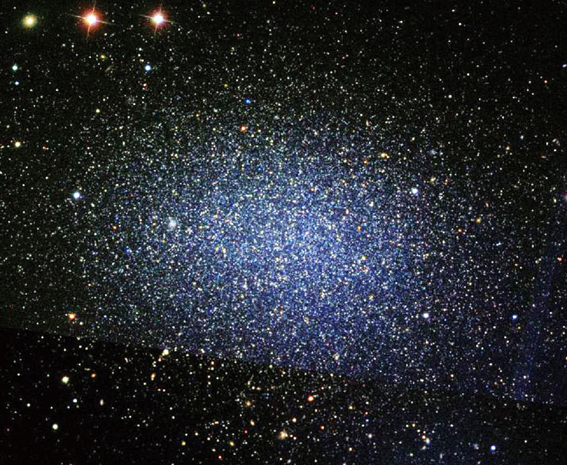
Leo I Dwarf Galaxy, located about 820,000 light-years away from us in the constellation Leo, is thought to be the most distant of the eleven known small satellite galaxies orbiting our Milky Way galaxy. It has been suggested that Leo I is in fact a tidal debris stream in the outer halo of the Milky Way, although the hypothesis has not been confirmed. (Credit: WikiSky, snapshot based on Sloan Digital Sky Survey)
Astronomers from the Chinese-French international lab LIA-ORIGINS have refuted the formerly well-established proof of dark matter in dwarf galaxies. They demonstrated that star motions in dwarf galaxies, which were believed to be governed by in-situ dark matter, are actually induced by gravitational forces of the Milky Way.
Since the 1970s, astronomers have been convinced that dark matter is the main component of the matter in the Universe. American astronomer Vera Rubin was the first to realize the need for dark—or invisible—matter to exist to explain the high-speed rotating gas at the edge of galactic disks. Later, the hypothesis was supported by Dutch astronomer Albert Bosma, who confirmed the role of dark matter at much further distances from the disk within the galactic haloes. In the 1980s, American astronomer Marc Aaronson discovered a similar effect—this time within the tiny galaxies surrounding the Milky Way.
Likewise, when scientists studied the motion of stars in newly discovered dwarf galaxies, they confirmed that stellar motions are too fast to be governed only by gravitational forces with visible mass. Their calculations indicated that the smallest nearby dwarf galaxy may contain thousand times more dark matter than visible matter.
An insufficiently explored alternative: the Milky Way gravitational force
The tiniest dwarf galaxies contain only a few thousand stars and are so faint that they cannot be observed elsewhere, beyond the halo of the Milky Way. By analyzing their dynamical properties, a French-Chinese team of astronomers from the Paris Observatory (PSL), the National Astronomical Observatory of the Chinese Academy of Sciences (NAOC), and the CNRS has discovered an exceptionally strong relation between the assumed dark matter content in most dwarf galaxies and the gravitational force due to the Milky Way.
They found the relationship is so strong that the probability it is only due to a coincidental chance is smaller than one part over ten billion. It implied that the Milky Way gravitation does control the stellar motions in these dwarf galaxies, and conversely, that the in-situ dark matter does not. The astronomers have also shown that the correlation does not depend on stellar mass.
A new scenario
The Milky Way can indeed affect the stellar dynamics in dwarf galaxies through gravitational tides. The astronomers have demonstrated that if these dwarf galaxies were encountering the Milky Way halo for the first time, they can be significantly driven out of equilibrium, and their stellar motions can be fully governed by the Milky Way gravitational forces, without any need for dark matter in dwarf galaxies.
Such an alternative has been only rarely considered for dwarf galaxies populating the Milky Way halo. They were more generally considered as satellites orbiting around the Milky Way for several billion years. The alternative scenario is also supported by the fact that the two more massive dwarf galaxies in the Milky Way halo, the Magellan Clouds, are indeed at their first passage.
This new scenario fully explained the exceptionally strong correlation between the supposed invisible mass in dwarf galaxies and the Milky Way gravitational acceleration or force. During the last billion years, several small galaxies that were rich in cold gas have approached the Milky Way environment. The Milky Way halo contains very hot gas at temperatures larger than one million degrees that has stripped the cold gas of dwarf galaxies, providing large instabilities in the motions of residual stars. Then dwarf galaxies were out of equilibrium when they reached the Milky Way, which fully controlled motions of their stars.
The astronomers have shown that by only knowing the dwarf galaxy distances to the Milky Way as well as their radii, one may predict accurately their stellar motions, which is measured by the velocity dispersion along the line of sight.
A change of paradigm for dark matter in dwarf galaxies
This study may affect most of our knowledge about the dark matter content in dwarf galaxies, since it could be extended to those in the neighborhood of the Andromeda galaxy.
“These results do not prove the absence of dark matter in dwarf galaxies, although there is no reason to further suppose its presence in absence of any proof”, specifies Francois Hammer, an PSL astronomer and first author of the study. The team will work to verify their predictions in particular using the last results of the Gaia satellite.
The study has appeared in the June 14 issue of Astrophysical Journal.

